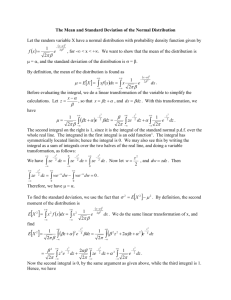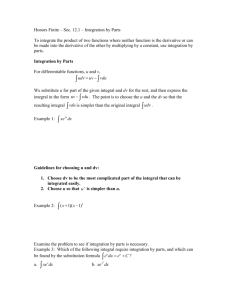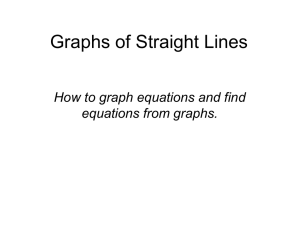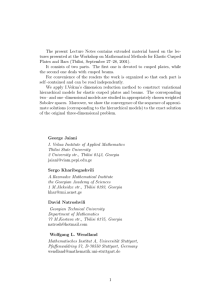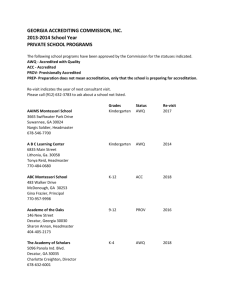Work and Line Integrals
advertisement
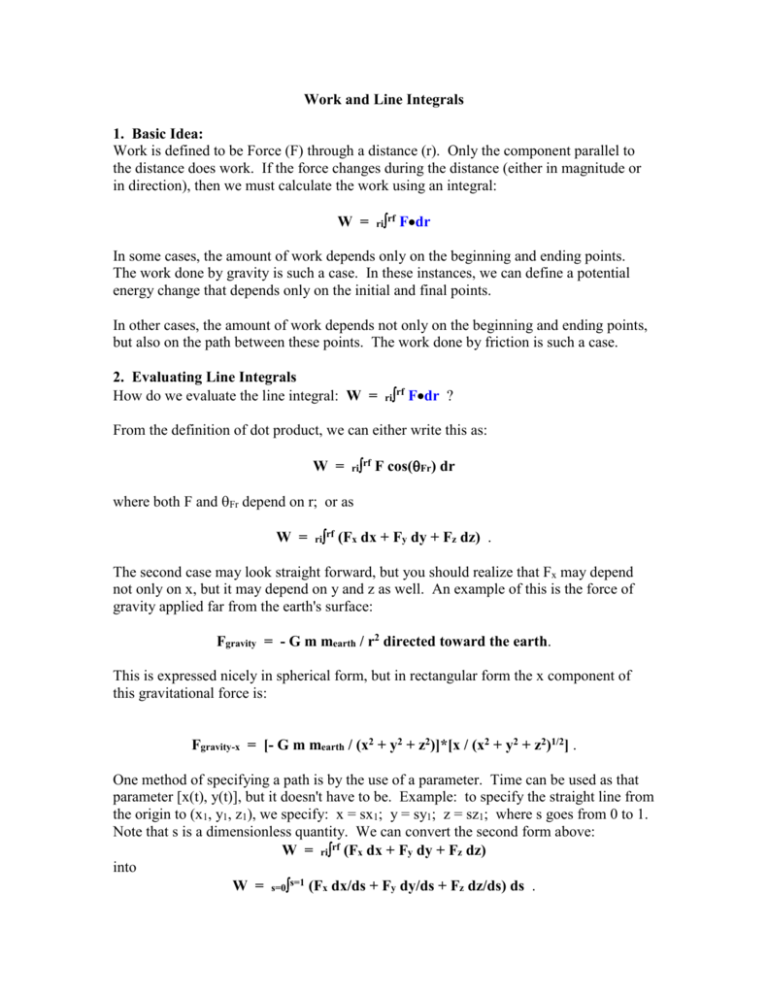
Work and Line Integrals 1. Basic Idea: Work is defined to be Force (F) through a distance (r). Only the component parallel to the distance does work. If the force changes during the distance (either in magnitude or in direction), then we must calculate the work using an integral: W = rirf Fdr In some cases, the amount of work depends only on the beginning and ending points. The work done by gravity is such a case. In these instances, we can define a potential energy change that depends only on the initial and final points. In other cases, the amount of work depends not only on the beginning and ending points, but also on the path between these points. The work done by friction is such a case. 2. Evaluating Line Integrals How do we evaluate the line integral: W = rirf Fdr ? From the definition of dot product, we can either write this as: W = rirf F cos(Fr) dr where both F and Fr depend on r; or as W = rirf (Fx dx + Fy dy + Fz dz) . The second case may look straight forward, but you should realize that Fx may depend not only on x, but it may depend on y and z as well. An example of this is the force of gravity applied far from the earth's surface: Fgravity = - G m mearth / r2 directed toward the earth. This is expressed nicely in spherical form, but in rectangular form the x component of this gravitational force is: Fgravity-x = [- G m mearth / (x2 + y2 + z2)]*[x / (x2 + y2 + z2)1/2] . One method of specifying a path is by the use of a parameter. Time can be used as that parameter [x(t), y(t)], but it doesn't have to be. Example: to specify the straight line from the origin to (x1, y1, z1), we specify: x = sx1; y = sy1; z = sz1; where s goes from 0 to 1. Note that s is a dimensionless quantity. We can convert the second form above: W = rirf (Fx dx + Fy dy + Fz dz) into W = s=0s=1 (Fx dx/ds + Fy dy/ds + Fz dz/ds) ds . Another example of using a parameter to specify a path is for the case of a circular path. Here we use an angle as our parameter, remembering that the angle (measured in radians) is related to the arclength and radius: = s/r, so the circular path is just the arclength, and ds = r d. Recall that for a circle, r = constant. Example: (Problem 3-12 in the text) Given that we have a force: Fx = ax3 + bxy2 + cz Fy = ay3 + bx2y Fz = cx . a) What is the work done in moving from the origin to position (x1, y1, z1) along the straight line connecting the origin to this point? Let's use the parameter way of specifying the path: to specify the straight line from the origin to (x1, y1, z1), we specify: x = sx1; y = sy1; z = sz1; where s goes from 0 to 1. Note that s is a dimensionless quantity. We use: W = s=1 s=0 (Fx dx/ds + Fy dy/ds + Fz dz/ds) ds . Note also that dx/ds = x1, dy/ds=y1, and dz/ds = z1 . Note also that Fx = ax3 + bxy2 + cz = ax13s3 + bx1y12s3 + cz1s Fy = ay3 + bx2y = ay13s3 + bx12y1s3 Fz = cx = cx1s . Thus, we have: W = s=1 s=0 [(ax13s3 + bx1y12s3 + cz1s)x1 + (ay13s3 + bx12y1s3)y1 + (cx1s)z1]ds Remember that x1, y1, and z1 are all constants. The integration is simply that of powers, and the integral is one with definite limits. Thus, upon integrating we get: W = [(¼ax13s4 + ¼bx1y12s4 + ½cz1s2)x1 + (¼ay13s4 + ¼bx12y1s4)y1 + (½cx1s2)z1]s=0s=1 It is easy to see that the lower limit (s=0) give zero, while the upper limit (s=1) merely causes all the s's to disappear (since s is dimensionless, we don't even have to worry about units). W = (¼ax13 + ¼bx1y12 + ½cz1)x1 + (¼ay13 + ¼bx12y1)y1 + (½cx1)z1 Doing a little re-arranging, we get: W = ¼ a(x14+y14) + ½ bx12y12 + cx1z1 . b) What would be the work done if we changed the path from the straight line from the origin to the point (x1,y1,z1) to the new path: origin to (x1,0,0) then from (x1,0,0) to (x1,y1,0) then from (x1,y1,0) to (x1,y1,z1) ? In this case, we break the integral into three separate integrals, one for each of the three straight paths. Over the first path, ds=dx with dy=0 and dz=0 (with y=0 and z=0 everywhere). Over the second path, ds=dy with dx=0 and dz=0 (with x=x1 and z=0 everywhere). Over the third path, ds=dz with dx=0 and dy=0 (with x=x1 and y=y1). W = rirf (Fx dx + Fy dy + Fz dz) = x=x1,y=0,z=0 x=0,y=0,z=0 Fx dx + x=x1,y=0,z=0 x=x1,y=y1,z=0 Fy dy + x=x1,y=y1,z=0 x=x1,y=y1,z=a1 Fz dz where in the first integral with y=0 and z=0 we have: Fx = ax3 + bxy2 + cz = ax3 and in the second integral with x=x1 and z=0 we have: Fy = ay3 + bx2y = ay3 + bx12y and in the third integral with x=x1 and y=y1 we have: Fz = cx = cx1 . Putting this altogether gives: W = x=x1 x=0 ax3 dx + y=0 y=y1 (ay3 + bx12y) dy + z=0 z=z1 cx1 dz = ¼ax14 + ¼ay14 + ½bx12y12 + cx1z1 . Note that the work done over each of the two paths we have considered is the same. If we were to change Fz to become Fz = dx2 instead of Fz = cx, then the two paths would give different results. When we look at the curl of a function, we'll see that we can predict when the force function will be independent of path and when it won't. Homework problem #14: A particle of mass, m, in the x-y plane is attracted to the origin (direction is negative radial) by a force that is inversely proportional to the distance from the x-axis, F(y) = k/y. Calculate the work done by the force from an initial point (x=0, y=a) to a final point (x=2a, y=0) along two different paths: a) along the sides of a rectangle: (x=0, y=a) to (x=2a, y=a) and then from (x=2a, y=a) to (x=2a, y=0); and b) along part of an ellipse: x=2a*sin() and y=a*cos() for from 0o to 90o. Note that the angle, , is only a parameter used to describe the path, and it is different from the angle the particle makes with the origin (which we usually label as ). HINT: du / [1+u²] = ln[u + SQR(1+u²)]
